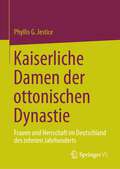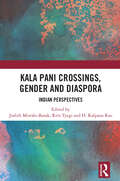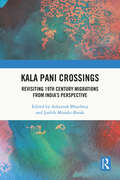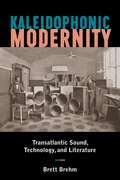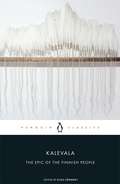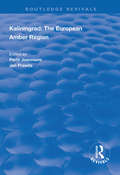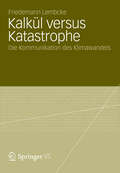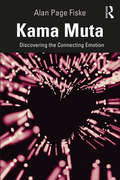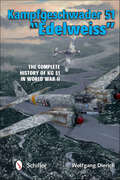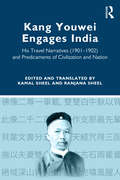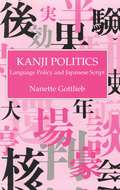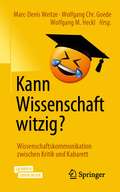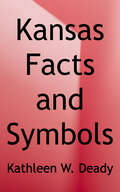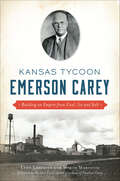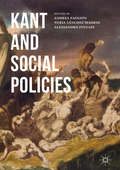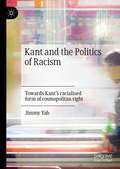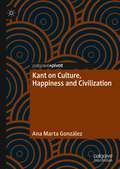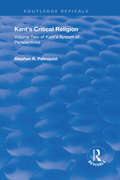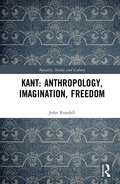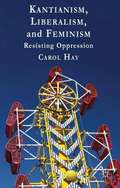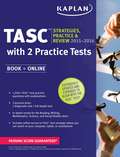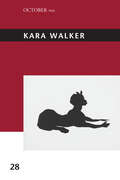- Table View
- List View
Kaiserliche Damen der ottonischen Dynastie: Frauen und Herrschaft im Deutschland des zehnten Jahrhunderts
by Phyllis G. JesticeIm Europa des zehnten Jahrhunderts und insbesondere in Deutschland konnten kaiserliche Frauen in einer Weise Macht ausüben, wie es in früheren Jahrhunderten kaum vorstellbar war. Theophanu und Adelheid waren zwei der einflussreichsten Persönlichkeiten im ottonischen Reich, zusammen mit ihren Ehemännern, die sich stark auf ihre Unterstützung verließen. Phyllis G. Jestice untersucht eine Reihe von Faktoren, die zu ihrer Macht und ihrem Prestige beitrugen, darunter die gesellschaftliche Einstellung gegenüber Frauen, ihr Reichtum, ihre Salbung als Königin und ihr sorgfältig aufgebautes Image der Frömmigkeit. Aufgrund ihrer einflussreichen Stellung konnten Theophanu und Adelheid die Herrschaft über den jungen Otto III. trotz des erbitterten Widerstands Heinrichs des Zänkers während des Thronstreits von 984 zurückgewinnen. Indem es untersucht, wie sie die Regentschaft erfolgreich sicherten, konfrontiert dieses Buch die überholte Vorstellung des Exzeptionalismus und beleuchtet das Leben der mächtigen ottonischen Frauen.
Kala Pani Crossings, Gender and Diaspora: Indian Perspectives
by Judith Misrahi-Barak Ritu Tyagi H. Kalpana RaoThis volume explores the intersections of diaspora and gender within the diasporic and Indian imagination. It investigates the ways in which race, class, caste, gender, and sexuality intersect with concepts of home, belonging, displacement and the reinvention of the nation and of self. Positioning itself as a companion to Kala Pani Crossings: Revisiting 19th century Migrations from India’s Perspective (Routledge, 2021), the present book examines whether indentureship and diasporic locations marginalised women and men or empowered them; how negotiations or resistances have been determined by race, class, caste, or ethnicity; how traditional standards of Indianness and gender relations have been reshaped; how ideas of home, self and the nation have been impacted in the diaspora and in India after the 19th and early 20th century indentureship migration; and what 21st century Indians stand to gain by theorizing the legacy of 19th century indenture through a gender framework. To understand how fiction and non-fiction writers have negotiated the legacy of indentureship to create spaces where normative practices can be interrogated and challenged, the book gives pride of place to interviews with writers such as Cyril Dabydeen, Ananda Devi, Ramabai Espinet, Davina Ittoo, Brij Lal, Peggy Mohan, Shani Mootoo, and Khal Torabully. Thus rooted in critical analyses but also in subjective and creative perspectives, this volume is a major intervention in understanding Indian indenture and its legacy in the diaspora and in India. It will be of great interest to scholars and researchers of literature, history, Indian Ocean studies, migration and South Asian studies.
Kala Pani Crossings: Revisiting 19th Century Migrations from India’s Perspective
by Judith Misrahi-Barak Ashutosh BhardwajWhen used in India, the term Kala pani refers to the cellular jail in Port Blair, where the British colonisers sent a select category of freedom fighters. In the diaspora it refers to the transoceanic migration of indentured labour from India to plantation colonies across the globe from the mid-19th century onwards. This volume discusses the legacies of indenture in the Caribbean, Reunion, Mauritius, and Fiji, and how they still imbue our present. More importantly, it draws attention to India and raises new questions: doesn’t one need, at some stage, to wonder why this forgotten chapter of Indian history needs to be retrieved? How is it that this history is better known outside India than in India itself? What are the advantages of shining a torch onto a history that was made invisible? Why have the tribulations of the old diaspora been swept under the carpet at a time when the successes of the new diaspora have been foregrounded? What do we stand to gain from resurrecting these histories in the early 21st century and from shifting our perspectives? A key volume on Indian diaspora, modern history, indentured labour, and the legacy of indentureship, this co-edited collection of essays examines these questions largely through the frame of important works of literature and cinema, folk songs, and oral tales, making it an artistic enquiry of the past and of the present. It will be of great interest to scholars and researchers of world history, especially labour history, literature, postcolonial studies, cultural studies, diaspora studies, sociology and social anthropology, Indian Ocean studies, and South Asian studies.
Kaleidophonic Modernity: Transatlantic Sound, Technology, and Literature
by Brett BrehmWhat stories remain hidden behind one of the most significant inventions of the nineteenth century? Kaleidophonic Modernity reexamines the development of mechanical sound recording technology by charting the orbits of writers, scientists, and artists in France and the United States. Working between comparative literature, the history of science, and urban studies, Brehm builds a bridge between visual culture and sound studies.Kaleidophonic Modernity places the poet and inventor Charles Cros and his lover, the celebrated concert pianist and salonnière Nina de Villard at the heart of modern aesthetic and scientific vanguards. Cros's scientific endeavors ranged from color photography, to telecommunications, to mechanical sound reproducibility. In his poetry the Surrealists found an ancestor and inspiration. His literary and scientific works prove startling and relevant to predicaments of technological media in his own time and ours. For nearly twenty years Nina de Villard presided over a supremely daring intellectual salon. There, she welcomed manifold literary, artistic, and musical luminaries into a veritable crucible of the artistic avant-garde and precursor to the famous Chat Noir cabaret. Together, these two forgotten but pivotal figures, Cros and Villard, help reframe our thinking on Edgar Allan Poe, Charles Baudelaire, and Walt Whitman, icons of urban modernity who can now be seen and heard in a kaleidophonic light, one that offers a compelling new perspective on modern mediascapes.In elaborating this transatlantic phenomenon, Kaleidophonic Modernity illuminates the prehistory of the phonograph as it intersects with the aesthetics of sound reproducibility, Franco-American literary exchange, Poe’s aesthetic and intellectual legacy, the sounds of modern cities and technologies, and the genealogy of audiovisual experimentation found in such movements as Dada, Futurism, and the sound art of today.
Kaleidoscopic Odessa
by Tanya RichardsonThe recent tumult of Ukraine's Orange Revolution and its aftermath has exposed some of the deep political, social, and cultural divisions that run through the former Soviet republic. Examining Odessa, the Black Sea port that was once the Russian Empire's southern window onto Europe, Kaleidoscopic Odessa provides an ethnographic portrait of these overlapping divisions in a city where many residents consider themselves separate and distinct from Ukraine. Exploring the tensions between local and national identities in a post-Soviet setting from the point of view of everyday life, Tanya Richardson argues that Odessans's sense of distinctiveness is both unique and typical of borderland countries such as Ukraine. Kaleidoscopic Odessa provides a detailed account of how local conceptions of imperial cosmopolitanism shaped the city's identity in a newly formed state. Richardson draws on her participation in history lessons, markets, and walking groups to produce an exemplary study of urban ethnography. Ethnographically sophisticated and methodologically innovative, Kaleidoscopic Odessa will interest anthropologists, Slavists, sociologists, historians, and scholars of urban studies.
Kalevala: The Epic of the Finnish People
by Elias Lönnrot'One of the great mythic poems of Europe' The New York TimesSharing its title with the poetic name for Finland - 'the land of heroes' - Kalevala is the soaring epic poem of its people, a work rich in magic and myth which tells the story of a nation through the ages from the dawn of creation. Sung by rural Finns since prehistoric times, and formally compiled by Elias Lönnrot in the nineteenth century, it is a landmark of Finnish culture and played a vital role in galvanizing its national identity in the decades leading to independence. Its themes, however, reach beyond borders and search the heart of human existence.Translated with an Introduction by Eino Friberg
Kaliningrad: the European Amber Region (Routledge Revivals)
by Pertti Joenniemi Jan PrawitzFirst published in 1998, this book reflects a concern for Kaliningrad. Too little is known about the region, developments in recent years have not been sufficiently covered and it is rarely integrated, in terms of analysis, with the way post-Cold War Europe is viewed more generally.
Kalkül versus Katastrophe
by Friedemann LembckeInsbesondere die Wissenschaft des Klimawandels beansprucht Öffentlichkeit und bekommt diese auch, allerdings in einem von Ambivalenz geprägten Verhältnis zu den Massenmedien. Friedemann Lembcke zeigt, dass es weniger um ein lösbares Problem in der Kommunikation des Klimawandels geht, als vielmehr um eine wechselseitige Bedingtheit von Kalkül- und Katastrophenkommunikation.
Kama Muta: Discovering the Connecting Emotion
by Alan Page FiskeThis book describes a ubiquitous and potent emotion that has only rarely and recently been studied in any systematic manner. The words that come closest to denoting it in English are being moved or touched, having a heart-warming feeling, feeling nostalgic, feeling patriotic, or pride in family or team. In religious contexts when the emotion is intense, it may be labeled ecstasy, mystical rapture, burning in the bosom, or being touched by the Spirit. All of these are instances of what scientists now call ‘kama muta’ (Sanskrit, ‘moved by love’). Alan Page Fiske shows that what evokes this emotion is the sudden creation, intensification, renewal, repair, or recall of a communal sharing relationship – when love ignites, or people feel newly connected. He explains the social, psychological, cultural, and likely evolutionary processes involved – and how they interlock. Kama muta is described as it manifests in diverse settings at many points in history across scores of cultures, in everyday experiences as well as the peak moments of life. The chapters illuminate the occurrence of kama muta in a range of contexts, including religion, oratory, literature, sport, social media, and nature. The book will be of interest to students and scholars from a number of disciplines who are interested in emotion or social relationships. Supplementary notes can be found online at: www.routledge.com/9780367220945
Kampfgeschwader 51 "EdelweiSS": The Complete History of KG 51 in World War II
by Wolfgang DierichRare unit history of a World War II Luftwaffe bomber unit
Kang Youwei Engages India: His Travel Narratives (1901–1902) and Predicaments of Civilization and Nation
by Kamal Sheel Ranjana SheelThis book is the first annotated translation of the travelogues of Kang Youwei, one of the most famous intellectuals and modernisers of late 19th-century China. These travelogues offer insights into Kang’s perceptions of India, which influenced modern intellectual discourse on India in China. These perceptions not only had a great impact on the thinking of other intellectuals but were also responsible for the larger construct that China developed about India during the republican and post-liberation period. The texts provide meaning to many dilemmas and predicaments that enshrouded the concept of civilisation and its linkages with the modern concepts of nationalism and modernity in Asian countries such as China and India. They are a valuable prism in gauging the early 20th-century intellectual and Chinese moderniser mind as it grappled with the challenges and uncertainties of those times. An important contribution to the study of Sino-Indian interactions, the book will be an indispensable resource for students and researchers of nation, nationalism, civilisation, empire, modern history, translation studies, Chinese Studies, and Asian studies.
Kanji Politics
by GottliebFirst Published in 1995. Routledge is an imprint of Taylor & Francis, an informa company.
Kann Wissenschaft witzig?: Wissenschaftskommunikation zwischen Kritik und Kabarett
by Marc-Denis Weitze Wolfgang M. Heckl Wolfgang Chr. Goede"Kann Wissenschaft witzig?“ nimmt ein ebenso innovatives wie zukunftsträchtiges Element moderner Wissenschaftskommunikation unter die Lupe: Die Komik!Leserinnen und Leser werden durch anschaulich gehaltene akademische Theorie sowie spannende Hands-on- und Best Practice-Beispiele renommierter Praktiker und Kabarettisten geführt:· Was haben Schafskäse und Autoreifen gemeinsam?· Kann Lachen Mauern einreißen lassen?· Wie funktioniert „Die Anstalt“· Wie schafft Zauberkunst Wissen?· Gibt es Humor im Museum?· Kommt ein Dalmatiner an die Kasse· Drei Schritte zum Humor· Serviervorschlag für den Heiligen Geist· Diktatur der Dummheit· Und viel mehr!Das ist aber nicht alles nur lustig. Komik kann auch Kritik etwas von ihrer beißenden Schärfe nehmen, die Kritik für die Adressaten verdaulich, ja sogar schmackhaft machen.„Kann Wissenschaft witzig?“ navigiert zwischen Kritik und Kabarett und setzt sich mit Komik in verschiedenen Spielarten aus unterschiedlichen Perspektiven auseinander. 22 Beiträge zeigen, wie sich die Ergebnisse von Wissenschaft, Forschung, Technologie auf neuen Wegen in die breite Öffentlichkeit tragen lassen. Sie demonstrieren insbesondere auch, wie Humor sich als kritisch-fragende Kraft einsetzen lässt – wertvoll für sämtliche Kommunikationsarten und hilfreich, damit sie in Zukunft gewitzter daherkommen.
Kansas Facts and Symbols
by Kathleen W. DeadyThis book presents information about the state of Kansas, its nickname, motto, and emblems.
Kansas Tycoon Emerson Carey: Building an Empire from Coal, Ice and Salt
by Lynn Ledeboer"I've seen a fly make a bull switch his tail" is a homespun quip attributed to Emerson Carey, the powerful salt magnate of Hutchinson, Kansas. True or not, the quote epitomizes the fearless and tenacious character of the legend who became Reno County's benefactor. Young, awestruck Carey arrived in boomtown 1880s Hutchinson and went on to create an immense empire. Coal, ice, salt, strawboard, egg cases, bags, soda ash and streetcars--he presided over it all. From Carey's sleeping in a coal yard with a quarter in his pocket to the founding of the exclusive Willowbrook community and attaining a net worth of more than $15 million, authors Lynn Ledeboer and Myron Marcotte relate the epic story.
Kant and Social Policies
by Andrea Faggion Alessandro Pinzani Nuria Sanchez MadridThis book discusses the potential for Kant's political and juridical philosophy to shed light on current social challenges and policy. By considering Kant as a contemporary and not above moral responsibility, the authors explore his political theory as the philosophical foundation of human rights, discussing the right to citizenship, social dynamics and the scope of global justice. Focusing on topics such as society, Kant's position on human rights, domestic economic justice, public education and moral virtue, the authors analyse the shortcomings of Kant's modes of thought and help the reader to gain new perspective both on this classical thinker and on more contemporary issues.
Kant and the Politics of Racism: Towards Kant’s racialised form of cosmopolitan right
by Jimmy YabThis book proposes an account of the place of the theory of race in Kant’s thought as a central part of philosophical anthropology in his political system. Kant’s theory of race, this book argues, is integral to the analysis of the “Charakteristik” of the human species and determined by human natural predispositions. The understanding of his theory as such suggests not only an alternative reading to the orthodox narrative we have seen so far but also reveals the underlying centrality of the notion of human natural predispositions in a way that is consequential for Kant’s philosophy as a whole. What is the impact of Kant’s racial theory on his philosophy and political thought? Is Kant a consistent egalitarian or a partisan Universalist thinker? Is he the symbol of racist prejudices of his time? What is the influence of his racial hierarchy on his cosmopolitan right? Or more simply, is Kant racist? From a systematic examination of Kant relevant writings, this book provides answers to these questions and shed light on two fundamental problems of his theory of race for moral philosophy, namely: (1) the completeness of the character of the White race and (2) the dispossession of the character of the beauty and the dignity of human nature of the Negro race. These two issues, unperceived from the “orthodox” reading’s perspective, however, uncovered by the “heterodox” reading, not only shape Kant’s race thinking from the beginning to the end of his life, transform his cosmopolitan right into a non-universalist form of right, but merely define Kant as a fundamental racist thinker since he developed the anthropology, the philosophy, and the politics of racism in a systematic way.
Kant on Culture, Happiness and Civilization
by Ana Marta GonzálezThis book joins the contemporary recovery of Kant’s empirical works to highlight the relevance of his concept of culture for understanding the sources of various characteristic modern dilemmas, such as the tension between culture and happiness, the morally ambivalent nature of cultural progress, or the existing conflicts between a factual plurality of cultures and the historical forces pressing toward a universal civilization. The book will be of special interest for Kantian scholars, moral and political philosophers, as well as philosophers of culture.
Kant's Critical Religion: Volume Two of Kant's "System of Perspectives" (Routledge Revivals)
by Stephen R. PalmquistThis title was first published in 2000. Applying the new perspectival method of interpreting Kant he expounded in earlier works, Palmquist examines a broad range of Kant's philosophical writings to present a fresh view of his thought on theology, religion, and religious experience.
Kant's Lectures on Anthropology
by Alix CohenKant's lectures on anthropology, which formed the basis of his Anthropology from a Pragmatic Point of View (1798), contain many observations on human nature, culture and psychology and illuminate his distinctive approach to the human sciences. The essays in the present volume, written by an international team of leading Kant scholars, offer the first comprehensive scholarly assessment of these lectures, their philosophical importance, their evolution and their relation to Kant's critical philosophy. They explore a wide range of topics, including Kant's account of cognition, the senses, self-knowledge, freedom, passion, desire, morality, culture, education and cosmopolitanism. The volume will enrich current debates within Kantian scholarship as well as beyond, and will be of great interest to upper-level students and scholars of Kant, the history of anthropology, the philosophy of psychology and the social sciences.
Kant: Anthropology Imagination Freedom (Morality, Society and Culture)
by John RundellIn a new reading of Immanuel Kant’s work, this book interrogates his notions of the imagination and anthropology, identifying these – rather than the problem of reason – as the two central pivoting orientations of his work. Such an approach allows a more complex understanding of his critical-philosophical program to emerge, which includes his accounts of reason, politics and freedom as well as subjectivity and intersubjectivity, or sociabilities. Examining Kant’s theorisation of the complexity of our phenomenological existence, the author explores his transcendental move that includes reason and understanding whilst emphasising the importance of the faculty of the imagination to undergird both, before moving to consider Kant’s pluralised, transcendental notion of freedom. This outstanding book will appeal to scholars with interests in philosophy, politics, anthropology and sociology, working on questions of imagination, reason, subjectivities and human freedom.
Kantianism, Liberalism, and Feminism
by Carol HayIn this book Hay argues that the moral and political frameworks of Kantianism and liberalism are indispensable for addressing the concerns of contemporary feminism. After defending the use of these frameworks for feminist purposes, Hay uses them to argue that people who are oppressed have an obligation to themselves to resist their own oppression.
Kants 4. Frage: Was ist der Mensch? (Colloquium Metaphysicum)
by Robert TheisIn seiner berühmten Logikvorlesung stellt Immanuel Kant die berühmten Leitfragen der Philosophie "Was kann ich wissen?", "Was soll ich tun?" und "Was darf ich hoffen?". Dem fügt er dann die Frage "Was ist der Mensch?" an und schreibt, all das, was in den ersten Fragen behandelt würde, könne man zur vierten zählen. Dieses Buch fragt demnach nach dem anthropologischen Subtext der drei ersten Fragen, also: Was erfahren wir über die vierte Frage, wenn Kant sich der Wissens-, Sollens- und Hoffensfrage zuwendet?
Kaplan TASC Strategies, Practice, and Review 2015-2016
by KaplanComprehensive content review, strategies, and practice for all sections of the TASC (Test Assessing Secondary Completion) from top test experts.
Kara Walker (October Files #28)
by Vanina GéréSelected texts that survey the full range of Kara Walker&’s artistic practice, emphasizing the work itself rather than the debates and controversies around it.Kara Walker&’s work and its borrowings from an iconography linked to the fantasized and travestied history of American chattel slavery has been theorized and critiqued in countless texts throughout her career. Exegeses of her work have been shaped by the numerous debates on the very debates it generated. How, then, do we approach a work that has been covered by such &“thick theoretical layers&”? This collection is unique in emphasizing Walker&’s work itself rather than the controversies surrounding it. These essays and interviews survey Walker&’s artistic practice from her early works in the 1990s through her most recent ones, from her famous silhouette projects to her lesser-known drawings and lantern shows. The texts, by art historians, curators, critics, scholars, and writers engage scrupulously with Walker&’s pieces as material works of art, putting them in the context of the sociopolitical and cultural environments that shape—but never determine—them. They include an interview of the artist by Thelma Golden of the Studio Museum in Harlem; an essay in the form of a lexicon, cataloguing key elements in Walker&’s art, by curator Yasmil Raymond; and an essay by volume editor Vanina Géré on Walker&’s use of historical archives. Finally, novelist Zadie Smith considers Walker&’s public art as counter-propositions to colonial monuments and as a reflection on colonial history. ContributorsLorraine Morales Cox, Vanina Géré, Thelma Golden, Tavia Nyong&’o, Yasmil Raymond, Jerry Saltz, Zadie Smith, Anne M. Wagner, Hamza Walker
